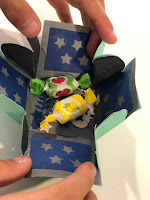Explosion boxes

Box example Explosion Boxes If you love pop-ups – those playful, joyful constructions that bring books and cards to life – then you will enjoy making “ explosion boxes .” These popular 3D paper crafts take pop-ups to a whole new world. Like pop-ups, “explosion boxes” offer an engaging way to invite students into the world of math and engineering. They encourage students to explore and work with measurement, parallel and perpendicular lines, angles, triangles, symmetry, and transformational geometry, all in the context of engaging students to design and make themselves. Although the deepest learning comes when students design from scratch, The simple explosion box shown here is designed to enclose a small Valentine’s Day treat, gift, or note. It can be printed first and then cut, or cut without printing from coloured card stock or plain white paper that students decorate themselves. Box Example ...
